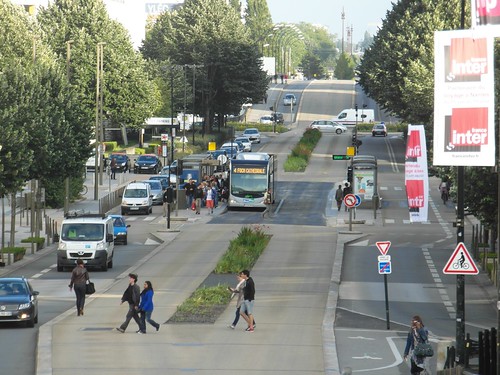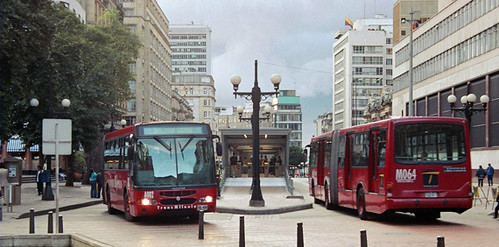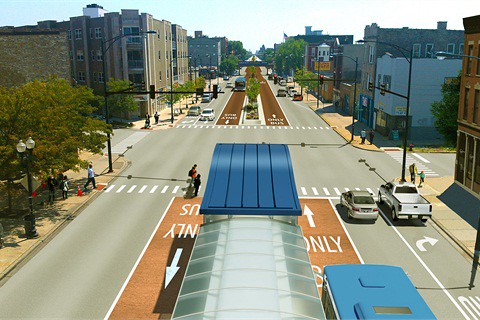Opponents of the CTA’s plan to build fast, reliable bus rapid transit on Ashland Avenue have argued that, despite the success of BRT in numerous international and U.S. cities, Ashland is a unique street where converting car lanes to dedicated bus lanes won’t work. Streetsblog readers also have asked for examples of systems that share the elements of the CTA’s plan: a four-lane street converted to two travel lanes plus center-running bus lanes, with most left turns prohibited, on-street parking, and some local, curbside bus service retained.
While no other street is going to have the exact same characteristics as Ashland, after some research I’ve found some best practices from other cities that show that most of these elements are quite common in successful systems. Cleveland’s HealthLine, which runs 6.8 miles along Euclid Avenue from the city center to an eastern suburb, is a good example of a four-to-two conversion close to home.
The buses have dedicated, center-running lanes in the highest ridership areas, such as downtown, with one travel lane on either side for mixed traffic, and then switch to curbside operation in lower-demand sections. On-street parking has been retained in some sections, and in a stretch between two universities, bike lanes replace the parking lanes.
The HealthLine debuted in 2008, and about a year later ridership had risen by 47 percent compared to the previous Euclid bus line. Despite the lane conversions, other traffic on the street continued to flow smoothly. As is predicted with Ashland, some of the traffic on Euclid switched to parallel streets. This phenomenon should work particularly well in Chicago since we have such an extensive, consistent grid system, so there are several alternatives to Ashland, such as Halsted, Damen, Western and California.
The French cities of Nantes and Rouen, as well as Utrecht in the Netherlands, have streets with two-way, center-running BRT and one general travel lane on each side and, in some cases, curbside parking. Downtown Johannesburg, South Africa, includes similar configurations, with two out of four travel lanes converted to bus lanes, albeit on one-way streets, with some on-street parking retained.
While many BRT corridors around the world are located mainly on wide, multilane arterials, when these routes enter the cities’ central business districts, the busways occupy most, if not all, of the streets they run on. For example, many photos of Bogotá, Colombia’s TransMilenio system show the buses on highway-like streets, but when the buses enter the city center they run on bus-only streets. Converting two out of four lanes on Ashland will actually be a much less dramatic change than what has been done in Bogotá and many other global cities.
As for the proposed left-turn bans on Ashland, it turns out that most of the world’s high-quality BRT systems feature this prohibition. Stateside, Cleveland has banned many left turns along Euclid, and the SDX (Strip-Downtown Express) in Las Vegas also prohibits left turns at some intersections to expedite the buses.
San Francisco and New York City are also starting to ban lefts on some of their non-BRT streets to improve safety and traffic flow. Left turns across two-way streets create elevated risks for pedestrians -- while turning drivers are looking for gaps in traffic, they're not paying attention to people crossing the street in their path. At intersections where left turns have a dedicated signal phase, eliminating that phase gives more green time to through traffic. That’s something Chicago might want to consider on other streets besides Ashland in order to make them operate more efficiently.
Some BRT skeptics in Chicago are concerned that the CTA’s plan to keep some curbside, local service will mean that buses entering and exiting stops will delay other vehicles in the remaining travel lanes. The locals are being retained largely for the benefit of people with mobility impairments, who would prefer not to travel an extra block or two to BRT stations spaced every half mile.
Unlike four-to-two conversions and left turn bans, I haven't come across examples of systems that retain curbside local service along with BRT. This may be due to the fact that in the U.S., where the bus is often viewed as a transportation option of last resort, a high proportion of riders are seniors and people with disabilities, whereas in other countries buses are ridden by a broader demographic. There also tends to be a high level of community input on transportation projects in this country, which makes it more politically challenging to remove existing bus stops. At any rate, the locals on Ashland will be so infrequent, arriving perhaps once or twice an hour, that they should have little effect on other traffic.
Aside from the local bus issue, the planned Ashland configuration is fairly typical of high-quality BRT systems anywhere in the world. That should make residents and business owners along the corridor feel more comfortable that the CTA’s plan doesn't represent a radical experiment, but rather a sensible repurposing of the street with a proven track record.







